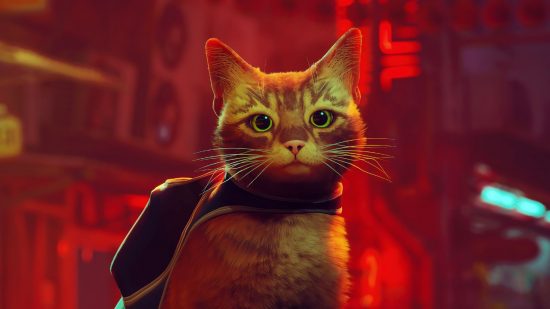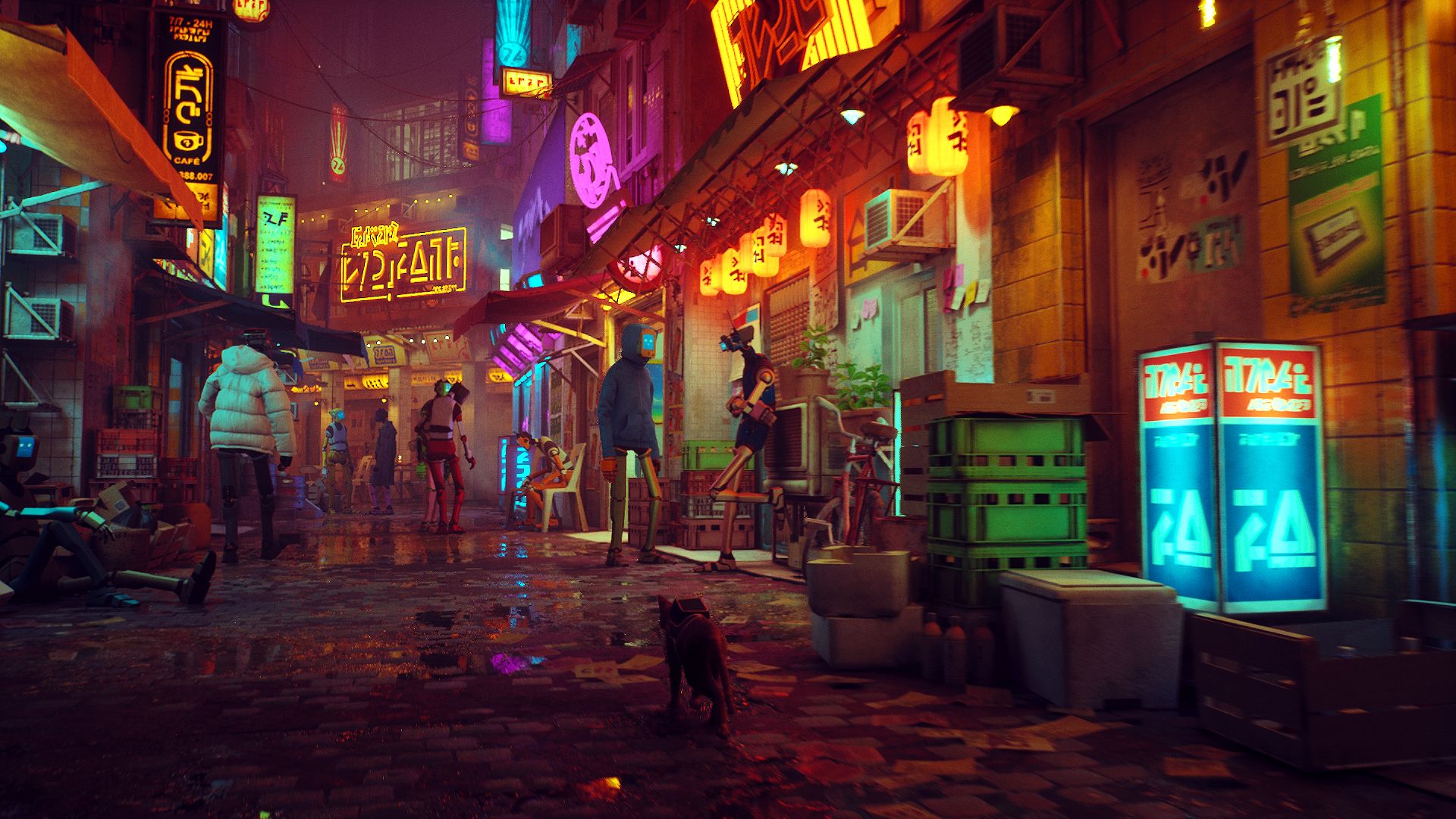Our Verdict
Stray merges feline mayhem with a classic cyberpunk setting, inviting you to explore its neon dystopia while never taking itself too seriously.
Our Stray review begins with an acknowledgement of the hype that’s surrounded BlueTwelve Studio’s modest indie cat game since its announcement in 2020. The premise is simple, yet compelling: a wayward cat becomes trapped within the walls of an underground city inhabited by robots. In order to reunite with his colony, he must journey through the city, solving rudimentary platforming puzzles and unravelling the mystery at the heart of this narrative-driven experience as he goes. A tall order for a creature that sleeps twelve hours a day.
It’s immediately apparent that BlueTwelve Studio has gone to great lengths to make you feel like you’re playing as a cat. In true feline fashion, you can leap onto surfaces and send objects flying, tear up all manner of upholstery, and knock over tins of paint with just a nudge of your paw. These feline idiosyncrasies are silly in a way that they should be, but they also function as mechanics in their own right. Meowing lures enemies away from key positions, and clawing at doors or hanging drapery grants you access to hidden areas. During Stray’s quieter moments, you can curl up on a pile of discarded cushions for a cat nap – and will even be rewarded for it, once enough time has elapsed.
Ok, so that last one isn’t technically a mechanic, but it is extremely cute.
BlueTwelve Studio may have primed its pint-sized protagonist with animations suited to all scenarios, but to interact fully with everything in the Walled City, you’ll often need to call on your robot companion. Housed within the stray’s backpack, B-12 can collect items, hack terminals, and translate robotic language into… cat language. That said, B-12 isn’t just a tool – they’re a character in their own right. They have their own mystery to untangle, and their autonomy is reflected in the game’s mechanics; if you’re separated from B-12, you’ll feel that loss keenly through Stray’s gameplay.
It might disappoint some to learn that Stray’s Walled City is not an entirely open world. Instead, Stray’s twelve chapters take place in a different part of the city, each with its own mood and class of robotic society. But with this approach comes focus and curation; it’s clear that everything within has been placed with the intent to make the journey across the Walled City as immersive as possible, with the full spirit of feline exploration and experimentation in mind.
This curation is particularly evident in Stray’s environmental signposting, which is exceptional. Lanterns and emergency lights will cast a neon glow to let you know where to go next, and arrows emblazoned across billboards will often point to one of the many collectibles scattered throughout the world. Thankfully, signs are a natural part of any cityscape, and the Walled City is so visually busy that these directions rarely feel heavy-handed. Instead, you are gently guided toward points of interest on a subliminal level.
While they may look like mere rustbuckets at first blush, the inhabitants of the Walled City are both whimsical and strikingly human. They wear flower power fisherman hats and swaddle themselves in blankets. Many of the game’s side quests explore the familial ties that bind them: a robot known only as Grandma knits woollen items in her spare time; another mourns the loss of his father by propping himself up at a bar. Within the boundaries of the Walled City, robots emulate human emotions and societal structures, establishing the theme at the heart of Stray’s narrative.
Lurking behind the simple joy of playing as a small orange menace is an authentic cyberpunk narrative reflecting the very best and worst of humanity, including our inability to fix our own mistakes. The Walled City is drenched in neon, and also a huge amount of detritus. The corporate waste management company, Neco Corp, has its logo emblazoned across the city. Their slogan – “Don’t worry about trash, Neco Corp takes care of everything!” – rings hollow in a world that’s overflowing with discarded beer bottles, tin cans, and bags upon bags of waste. Stray’s progression involves a shocking descent into dystopian horror as the dark mystery at the heart of the Walled City unfolds.
Special mention must also be made of Stray’s dynamic soundtrack. It’s as much a part of the game’s atmosphere as its visuals, characterised by ethereal synth that is by turns gently optimistic and abruptly unsettling. Picking up a new item or clue to uncovering the mystery of the Walled City will often trigger a seamless shift to another track that deftly captures the parallel shift in the narrative, whether that be towards intrigue, mischief, or menace.
Stray is yet another golden feather in Annapurna Interactive’s cap, and encapsulates what we’ve come to expect from the games they publish: a highly polished narrative-driven experience, with an emotional and thought-provoking core. Its choice of protagonist feels earnest rather than gimmicky, and its world is a compelling character in itself. Perhaps more importantly, Stray is a salient first outing for BlueTwelve Studio that raises the question: what’s next?


